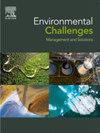利用空油棕束作为有机肥和生物炭改良土壤,提高棕榈油工业的环境绩效
Q2 Environmental Science
引用次数: 0
摘要
棕榈油行业在印尼经济中扮演着非常重要的角色,因为它对国家收入和就业做出了重大贡献。然而,该行业也面临着与环境影响相关的严峻挑战。集约型粗棕榈油(CPO)会产生大量的各种形式的废物,如固体、气体和液体废物,如果管理不当,会污染环境。CPO行业的主要废物之一是空果串(EFB),占加工新鲜水果的23 - 28% %。本研究旨在利用生命周期评估(LCA)方法分析棕榈油厂的环境影响,并评估利用棕榈油作为有机肥料和生物炭作为土壤改良剂的基础材料的改善潜力。这项研究是在印度尼西亚的三家棕榈油厂进行的。数据处理采用OpenLCA 2.3版软件结合Ecoinvent 3.9.1数据库。研究结果表明,温室气体排放的最大来源来自合成肥料的使用。通过施用有机肥料和由EFB生产的生物炭,可以大大减少合成肥料的使用。平均而言,每公顷合成肥料的使用量可以通过使用有机肥料或生物炭分别减少约75.27 %和34.85 %。因此,可以减少合成肥料的投入成本和温室气体的排放。本文章由计算机程序翻译,如有差异,请以英文原文为准。

Improving the environmental performance of palm oil industry through the utilization of empty oil palm bunches as organic fertilizer and biochar for soil amendment
The palm oil industry plays a very important role in the Indonesian economy, as it contributes significantly to state revenue and employment. However, this industry also faces serious challenges related to its environmental impacts. Intensive crude palm oil (CPO) produces various forms of waste in large quantities, such as solid, gas, and liquid waste, which pollute the environment if not managed properly. One of the main wastes from the CPO industry is empty fruit bunches (EFB), which amount to around 23–28 % of the fresh fruit processed. This study aims to analyze the environmental impacts of palm oil mills using the Life Cycle Assessment (LCA) approach and evaluate the potential for improvements by utilizing EFB as base material for organic fertilizer and biochar as a soil amendment. The research was conducted at three palm oil mills in Indonesia. Data processing uses OpenLCA software version 2.3 combined with the Ecoinvent 3.9.1 database. The results of the study indicate that the largest source of greenhouse gas emissions comes from the use of synthetic fertilizers. The use of synthetic fertilizers can be reduced significantly by applying organic fertilizers and biochar produced from EFB. On average, the use of synthetic fertilizers per hectare can be reduced by using organic fertilizers or biochar by approximately 75.27 % and 34.85 % respectively. As a result, synthetic fertilizer input costs and the greenhouse gas emissions can be reduced.
求助全文
通过发布文献求助,成功后即可免费获取论文全文。
去求助
来源期刊

Environmental Challenges
Environmental Science-Environmental Engineering
CiteScore
8.00
自引率
0.00%
发文量
249
审稿时长
8 weeks
 求助内容:
求助内容: 应助结果提醒方式:
应助结果提醒方式:


